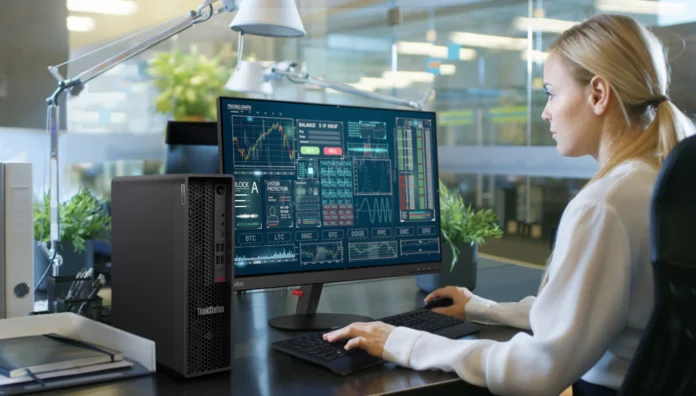A laptop seems like an on-the-go option for most of the daily activities. However, many of today’s laptops are high-powered machines better classified as workstation PCs.
The main question arises here: what is the difference between a workstation PC and a laptop? The former is designed to perform intense activities such as rendering, 3D animation, CAD, data analysis and video editing. And the latter fulfils your resource-intensive with a touch of portability and compatibility.
Let’s explore functionalities of both the devices and go for a comparative one:
| Features | Workstation PC | Laptop |
| Performance | High computing power, suitable for demanding tasks. | If you want to perform heavy-duty tasks in your laptops then you have to go for the models with high RAM capabilities. |
| Upgradability | Easily upgradeable and customizable. | With limited upgradability, you can only upgrade some of the laptop components like video cards, Wi-Fi cards etc. |
| Offline Operation | Workstation PCs can’t operate in an offline model. So, without a power supply your work can hamper. | Laptops have a win-win deal in this situation. Most of the file sharing has an offline mode. So, Yeah! You can perform your less-intensive tasks. |
| Portability | Workstation PCs are big in size so you can’t leave them anywhere. | Laptops are portable so you can let them anywhere. |
| Display Size & Quality | Larger monitors, high resolution, great for multitasking | Smaller screens, lower solution, suitable for on-the-go use |
| Heat Dissipation | Robust cooling systems for sustained heavy workloads | Limited cooling capacity due to the compact design. |
Heat Dissipation:
Workstation PCs develop robust cooling systems to manage the heat generated by high-performance components. This allows them to handle sustained heavy workloads. Laptops employ various cooling technologies but may experience thermal throttling due to limited cooling capacity in their compact form factor.
Connectivity:
Workstation PCs typically have many connectivity options, including multiple USB ports, audio jacks, Ethernet ports, and expansion slots. This allows users to connect various peripherals and accessories simultaneously. Laptops also offer connectivity options, but the number of ports may be limited due to their compact size and may require dongles for additional connections.
Graphics Performance:
PCs have dedicated workstation-class graphics cards that excel in professional 3D rendering, CAD/CAM applications, and GPU-accelerated tasks. Laptops usually feature integrated or mobile-grade graphics cards, which may deliver a different level of performance than their desktop counterparts, especially in demanding graphics-intensive workloads.
Audio Quality:
Workstation PCs may include high-quality audio components or support for external sound cards, making them suitable for audio production, music composition, and other tasks that require precise audio output. Laptops typically have integrated audio solutions, which may offer a different level of audio fidelity.
Expandability:
Workstation PCs have ample space for additional components, allowing users to add multiple hard drives, SSDs, and expansion cards for specialized functionality. Due to their compact design, laptops have limited space for adding internal components, and users often rely on external storage options.
Virtual Reality (VR) Support:
Workstation PCs with powerful graphics cards can support virtual reality experiences and VR content creation. Laptops with VR capabilities are available, but they can provide a different level of performance and immersion than high-end desktop systems.
Noise Level:
Workstation PCs can handle large cooling systems, which may result in higher noise levels during heavy processing. Some workstations, especially those optimized for quiet operation, can be relatively silent. Laptops, designed for mobility and energy efficiency, generally produce less noise during regular use.
Gaming Performance:
While not their primary focus, Workstation PCs with high-performance graphics cards can deliver excellent gaming performance. Gaming laptops are specifically designed for gaming and offer a balance between portability and gaming capabilities.
Power Consumption:
Workstation PCs typically consume more power than laptops due to their higher-performance components. Laptops, designed for energy efficiency and battery life, consume less power and are better suited for mobile use.
Build Quality:
Workstation PCs are often built with durability and sturdiness in mind, as they are rarely moved. Laptops designed for business or professional use may also have durable construction, but ultra-thin and lightweight consumer laptops may sacrifice some durability for portability.
Data Security:
Workstation PCs can benefit from advanced security features like BIOS-level encryption, hardware-based security modules, and additional security measures suitable for enterprise use. Laptops may also include security features, but the focus is often on convenience and user-friendly authentication methods.
ECC (Error Checking Memory):
The main difference between a workstation PC and a laptop is that the latter usually supports business activities. In contrast to this, workstations are built for individual purposes. These devices are mostly designed for engineers who always need high performance and have less tolerance for minor errors.
The configurations need only two things: error-checking memory (ECC) and certifications from software vendors who designed the apps to run on them.
Bottom Line:
Both Laptops and workstation PCs can handle resource-intensive tasks like video editing, gaming, designing, streaming etc. You have to make a choice as per your needs and compatibility issues.

